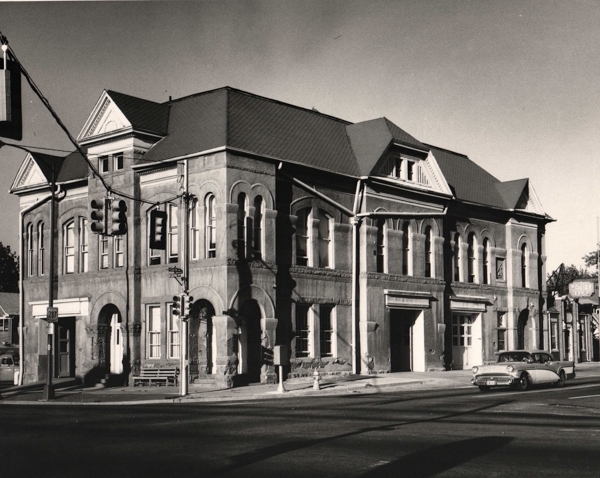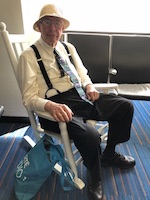
Many of Denver’s streetcar bedroom suburbs, originally independent cities ringing Denver, boasted elegant city halls. Highlands City Hall was one such fine example. William Quayle, noted architect, designed the three-story brick and sandstone building located in the center of the town at the southwest corner of West 26th Avenue and Federal Boulevard, where the modern Denver Fire Station No. 12 is now.

My uncle Bob Dieckman, whose dad was a baker, kept many a marriage together by providing gourmet meals at that firehouse for the firefighters stationed there. His son, Mark Dieckman, my first cousin, served the people of North Denver and the department for many years at the same station. I remember the old city hall and reported my bicycle stolen at the police station at the easterly corner of the building on West 26th Avenue. I think I was around six. North Denver’s finest never could find the bicycle.
Ruth Wiberg, in her wonderful book, Rediscovering Northwest Denver, reports that the Victorian building complete with bell tower had a large second floor room for municipal meetings and the traditional annual Highland Ball around New Year’s Day.
The building dedication on July 11, 1890, ignited simmering hostility between Denver and Highlands into open warfare with the mayors of Denver and Highlands one upping each other on their city’s virtues. Mayor Lewis of Highlands said the residents of Highlands were happy to live in the city with clean air and pure water, the people were more intelligent and had a city government better than any other city in the state. He went on to pour salt in Denver’s wounds by announcing that Highlands had no houses of ill fame and not one saloon within the city limits. At this time, Denver’s Red Light District on Halliday Street (later Market Street) competed with the best of European Bordello districts in the folklore about our city internationally.
In his testy response to Mayor Lewis, Denver’s Mayor Wolfe Londoner rose to the verbal challenge, telling the assembled Highlanders that the only way their city would see an increase in population was by coming into Denver not spreading out to the western foothills. Wiberg quotes Londoner, “I wouldn’t have said a word if your mayor had not pitched into me, but unless you annex yourself to Denver, I don’t see how you can get the viaduct you want.” This rancorous rhetoric echoes comments today especially when you listen to folks in Adams County talk about how Denver treats them over all the perks from the airport.
Highlands had its own fire department, too. Captain Patrick Carey would unhitch the city fire horses from the fire wagon at West 32nd Avenue and Wyandotte Street when Mother Francis Cabrini asked him to drive her and her nuns to the mountains to look for land for a mountain retreat for her orphans. Today, Denver’s vigorous Ethics Commission would undoubtedly fire Captain Carey for using city fire horses for private purposes!
Captain Carey’s family told me that whenever Captain Carey had the nuns in a wagon pulled by city horses, there was never a fire in North Denver. Even Protestants were asking Captain Carey to take Mother Cabrini for another ride to the mountains. Mother Cabrini’s Shrine is still located on I-70 just before you get to the Genessee turnoff. An unscrupulous realtor sold the land cheap to Mother Cabrini, our first American saint, an Italian immigrant and patron of immigrants.
The water surveyors told the realtor there was no water under the worthless land. Mother Cabrini got the land for a steal. Mother Cabrini walked across her new mountain retreat for orphans, hit a rock with her stick and up popped an artesian geyser. Up on her mountain, the munificent water supply is still all considered holy water. Visitors are welcome to visit the shrine and bring home the holy water for use around the house.
Highlanders voted against Denver annexation a few times but, finally, on June 22, 1896, the good people of Highlands voted over two-to-one to be annexed to the evil and sinful Denver. Wiberg informs us that there were no liquor outlets in Highlands until Prohibition was repealed in 1933. Mayor Londoner would be pleased to see so many liquor outlets in gourmet restaurants here in Highlands.
Denver turned the ornate Highlands City Hall into fire station number 12 until the nondescript utilitarian fire station replaced the old Highland City Hall torn down in 1966. I am pleased to report that Smiley Library keeps a copy of Ruth Wiberg’s book on reserve right next to Jerome Smiley’s Denver 1901. Mt. Carmel historic church, located at West 36th Avenue and Navajo Street, has a statue of Saint Francis Cabrini on the right side of the altar. As visitors walk near her statue, her eyes mysteriously always gaze directly upon you.
Photo of Highlands City Hall provided by Dennis Gallagher.
The Honorable Dennis Gallagher is a former city auditor, city councilman, state senator and state representative. He’ll be sharing thoughts and stories from North Denver’s past and future in his reoccuring column in the North Star.

Thank you Dennis. Nobody tells the important stories about the city as well as you do. Best, Susan Barnes-Gelt
Mr. Gallagher,
I happened upon his article and saw the references to my grandfather, Patrick Carey. I never met him – he died when my mother was 3 – but i do know about his connection to Mother Cabrini; I remember going to the shrine with my grandmother and bringing water hom.
I wonder if you haooen to know whether ther is a museum of the Denver or Highlands fire department? I have some itmes oc Captain Carey which they might find interesting. And perhaps I could find more about the Captain..
Regards